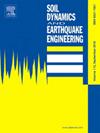Damage-based seismic performance design of reinforced concrete bridges using capacity-based inelastic displacement dual spectra
IF 4.6
2区 工程技术
Q1 ENGINEERING, GEOLOGICAL
引用次数: 0
Abstract
A damage-based seismic performance design method using capacity-based inelastic displacement dual spectra was proposed for reinforced concrete (RC) bridges, where the Park and Ang's damage index was introduced as the performance objective. The proposed method was composed of the recommended force-based seismic design method (Phase I) and the imperative pushover-based seismic evaluation procedure (Phase II), with a main focus on the damage evaluation of each bridge column given that the damage index can be well correlated to the strength deterioration state and visual damage condition of the bridge columns. It was verified against the nonlinear time-history analysis of various irregular bridges that the average result of the seismic evaluation utilizing the uniform and modal pushover analyses can provide reliable and acceptable evaluation results in terms of the maximum displacement and damage index profiles of the bridges when subjected to transverse seismic excursions. In addition, design illustration of the proposed design method was conducted using two long-period ( 0.7 s) and another two short-period ( 0.7 s) hypothetical bridges with regular and irregular configurations and compared to the design results per current Taiwan code, Caltrans SDC, and AASHTO's Guide Specification. It was found that the designed long-period irregular bridges and the short-period regular and irregular bridges could suffer severe damage when subjected to a maximum credible earthquake with the near-fault effect. The damage severity of a bridge will be determined by the interactively combined effects of ground motion characteristics, relative structural strength, structural period, bridge regularity, and damage potential.
基于承载力的非弹性位移双谱法的钢筋混凝土桥梁抗震性能损伤设计
提出了一种基于损伤的钢筋混凝土桥梁抗震性能设计方法,采用基于承载力的非弹性位移双谱法,将Park和Ang损伤指标作为抗震性能目标。该方法由基于推荐力的抗震设计方法(第一阶段)和基于强制推推的抗震评估程序(第二阶段)组成,考虑到损伤指标能很好地与桥梁柱的强度劣化状态和视觉损伤状态相关联,重点对桥梁柱进行损伤评估。通过对各种不规则桥梁的非线性时程分析,验证了均匀模态推倾分析的平均地震评价结果能够为桥梁在横向地震作用下的最大位移和损伤指标剖面提供可靠和可接受的评价结果。此外,采用两个长周期(Tn≥0.7 s)和两个短周期(Tn<;根据现行台湾规范、Caltrans SDC和AASHTO指南规范,对规则和不规则配置的假设桥梁进行了比较。研究发现,设计的长周期不规则桥梁和短周期规则和不规则桥梁在近断层效应的最大可信地震作用下会遭受严重破坏。桥梁的损伤严重程度将由地震动特性、相对结构强度、结构周期、桥梁规则性和损伤潜力的相互作用共同决定。
本文章由计算机程序翻译,如有差异,请以英文原文为准。
求助全文
约1分钟内获得全文
求助全文
来源期刊

Soil Dynamics and Earthquake Engineering
工程技术-地球科学综合
CiteScore
7.50
自引率
15.00%
发文量
446
审稿时长
8 months
期刊介绍:
The journal aims to encourage and enhance the role of mechanics and other disciplines as they relate to earthquake engineering by providing opportunities for the publication of the work of applied mathematicians, engineers and other applied scientists involved in solving problems closely related to the field of earthquake engineering and geotechnical earthquake engineering.
Emphasis is placed on new concepts and techniques, but case histories will also be published if they enhance the presentation and understanding of new technical concepts.
 求助内容:
求助内容: 应助结果提醒方式:
应助结果提醒方式:


